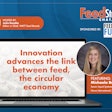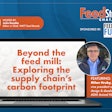
The Center for Environmental Sustainability through Insect Farming aims to advance insect agriculture with high-quality research.
PODCAST: How research can help insect production scale up (12:53)
Ann Reus: Hello and welcome to the Feed Strategy podcast. I’m your host, Ann Reus, senior reporter for Feed Strategy.
The Center for Environmental Sustainability through Insect Farming – or CEIF – is a consortium composed of three universities: Texas A&M AgriLife, Indiana University Purdue University Indianapolis — also known as IUPUI – and Mississippi State University. The National Science Foundation funded the formation and management of the center, which aims to provide high-quality research on insect farming to industry so companies can better expand their production of insect ingredients for animal feed and human food. All research funds are provided by industry advisory board members.
Today I’m speaking with Jeffery Tomberlin, who is the director of CEIF and a professor, AgriLife Research Fellow and Presidential Impact Fellow at Texas A&M.
Reus: Tell me about the NSF CEIF and what you do there.
Jeffery Tomberlin: Sure. I think before I tell you about what NSF CEIF is, it might help to have a little background on how it came about. It’s been a journey. We’ve been working on development of the center, this particular center through the National Science Foundation for about four years. It started with a small group meeting in Indianapolis with Christine Picard and Heather Jordan and others. That led to a planning grant – took a year to get the planning grant from NSF. We had the planning meeting, then a year later, we submitted a full proposal and the year after that we finally got the grant. So it was a journey. Because we had to bring companies in from all over the world because the purpose of this particular center is to bridge academia with industry. We want to provide quick results to help the industry evolve, diversify and navigate hurdles they may encounter along the way. And fortunately, the National Science Foundation found this topic interesting and they wanted to support it, because of its value not just to the United States, but the remainder of the globe. So what we do is we engage industry, we find out what their challenges are, we develop research within the center that we can then do with our different sites, Mississippi State, Texas A&M and IUPUI. We get those results back to the industry. So it’s quick turnaround results, low investment on their part, high return.
Reus: CEIF has three areas of research. Can you explain what those are?
Tomberlin: Sure. So each site has a particular emphasis. So Texas A&M, where I’m located, is emphasizing optimization of growth and production as well as feed trials. So we work with feed trials in aquaculture, poultry, etc. IUPUI, with Christine Picard, is focused on genetics and genomics, and Mississippi State with Heather Jordan is focused on microbiology, quality assurance issues.
Reus: What kind of work are you doing specifically around using insects in animal feed?
Tomberlin: Sure, so I can’t go into specifics about the projects that we’re currently running because the information is confidential. It’s only for the industry advisory board. So the companies that are part of the center have access to those data. But I can give you an idea of the type of projects that we can do. We obviously can do any type of aquaculture project that ranges from freshwater to coldwater to saltwater fish. We can do poultry work and look at growth and development and, across these species, we can look at immunological responses, sensory perception, does it affect the taste, or the quality of the animals that are being produced. And I imagine that eventually with the vet school here at Texas A&M, we’ll diversify and go into the pet food. On the feed side, what’s really fascinating is that there are companies that can digest 100 tons of food waste a day, every day with an insect. And this insect is you an inch long. But there’s so many of them, they can actually build these bioreactors to digest 100 tons of food waste a day to create products of value. That keeps us material out of the landfill. So if you consider like food production in the world, it’s hard to believe we live in an environment where like, hey, we need to produce more food, because our global population is growing. But we waste like 40% of the food we produce. This industry does a couple things. One, is it tightens up our economy and creates a more cyclic system where there’s no waste, or limited waste. And it diversifies the industry because this industry, while I say there are companies that can digest 100 tons of waste a day, anybody can do it. So we really like to spend a lot of time teaching people how to produce this insect. It’s almost like the victory gardens or of World War II, where everybody had their little garden in the back and was producing fruits and vegetables for the community. The same thing can be done with these insects like the black soldier fly one that I specialize on. Anybody can do it. And that’s the thing I like about it because we can take this into developing nations and you don’t have to have robots to do it, so we can help bolster economies in places that need it. And by bolstering these economies and creating jobs, we’re saving lives, we’re creating nutritive valued byproducts that can be used to grow livestock that then can be food. It protects the environment. There’s so many benefits that come from this.
Reus: How can CEIF help get black soldier fly production on the scale that is needed for the animal feed industry?
Tomberlin: Sure, so a lot of these companies, they range in size from startup to global entities, such as like Tyson Food Group, or Mars Corporation. And while they all have, these large companies have research arms, they don’t have experts in entomology. So that’s really challenging. The smaller companies obviously don’t have as much to invest in research arms. So what we can do is we can tap into that expertise, we bring the experts in to answer these questions. And that allows us to address those questions and get data to them so they can navigate this process of development and growth. And what I mean is, if we can develop methods that increase their production, or optimize their processes, 10, 15%, that’s a massive impact. Also, if we can help them develop the data that are necessary for regulatory approval, that’s even a bigger boon. So we are like quick return. These projects happen within a year to two years, so we’re generating data constantly. And one thing I’d like to point out is just to give you an idea of how this benefits companies, if you look at the center, right now, the National Science Foundation’s investing about a half a million dollars a year in the center, and that’s for the infrastructure side. The industry partners invest $25,000 or $50,000 a year per company. So right now, we’re talking close to a million dollars of research every year, and every company gets access to all of the data. So if you invest $25,000, you’re getting a return of a million dollars. So it’s huge returns. So again, how does industry benefit? It’s quick data turnaround for questions they are dealing with now, today, in the present.
Reus: Do you think insects will ever become widely accepted as food for humans?
Tomberlin: You know, that’s an interesting question, and I’m going to be a little cheeky with the response. But the first part is, it’s already accepted. If you think about the global population, a large portion of the global population already consumes insects. Well, what we’re talking about really is the Western world, getting the West to adapt or open, be receptive to the idea of insects as a food ingredient. So it’s not the idea of a cricket sitting on your hamburger, it’s how do you take the protein out of the cricket, and create an ingredient that can be then formulated and used in other food products? That’s what we’re talking about doing on the food side. On the feed side, I think we’re there. It’s now just growing the industry to meet the demand.
Reus: What are some of those ingredients or food products that can be used for human food?
Tomberlin: I mean, the big one is the protein that’s associated with the insect. So the protein could be extracted and then formulated, and you’ll see a variety of different things that are being produced today for human consumption, ranging from potato chips to ice cream.
Reus: What is it about insects that draws you to this work?
Tomberlin: Well, I’m an entomologist, so that helps, right? But I think for me, people ask me all the time, how did I get involved in this industry, and I tell people that it wasn’t one single event that led me to it. It was a sequence of experiences that I’ve had through my life. But I have to recognize my grandmother. My granny, she lived to be 98. She lived about 100 yards behind my house where I grew up, and I spent every day with her. I would come home from school, go in the front door, out the back and straight to her house. And just her way of living taught me the importance of sustainability, community and protecting the environment. And she didn’t talk in science terms. She had a third-grade education. She talked through her actions. And what I mean by that is, as I got older, and I learned more about her, and the way she grew up in the way she was committed to her family, it inspired me and I think that’s what led me to this area in the beginning. Real quick story about my granny, because it’ll give you an idea of the type of woman she was: She’d get up at four in the morning, milk the cow, come home, cook breakfast, go pick cotton, come home, cook lunch, go pick cotton, come home, cook dinner, and ever heard the woman complained a day in her life. She gave me this present that hangs in my house to this day, in a shadowbox and it’s a thimble that’s used for sewing. And she used it so much, she broke it, there’s a hole in it. And when I was getting married, I held that thimble up and I said, ‘I aspire to be this committed.’ And she laughed and I said, ‘Granny, why are you laughing?’ She said, ‘Oh, I have a whole jar of those.’ And to me, that lifestyle is what led me, in part, to be committed to this industry of circular economy, protecting the environment, creating jobs, community. So that was a long-winded rant, I’m sorry about that, but it’s part of who I am. It’s part of my DNA.
Reus: No, that’s a great story. I’m glad I asked the question. So you mentioned Tyson and Mars; what are some of the other companies that you work with?
Tomberlin: Sure. So Tyson and Mars are some of the big companies that do a lot of different things. And this is an area of interest that they have. So we also work with Ragn-Sells, that’s a waste management company out of Europe, we work with Innovafeed, we work with Enterra, we work with PreZero, these are all insect-based companies throughout the Western Hemisphere, so mostly in North America and Europe. We do have colleagues that are also in Asia. And we’re expanding every year, we’re trying to add more companies, because the more companies we have, the more work we can do and the more we can advance the industry. And I just want to point out, it’s not just about doing research, it’s also training the next generation of researchers and workers or employees for these companies. Because that’s a big hurdle. It’s having people that understand this sector and can work in it. So we are working to do that, to create the next generation. Something else, just so that you’re aware, it’s more than just also research or training. We also look at community engagement. We received a supplemental grant from the National Science Foundation, where we’re working with the Texas A&M Aggie ACHIEVE program and with the Mississippi State ACCESS program, and the purpose of these programs is to introduce science to marginalized communities. So, we work with individuals that normally wouldn’t get a chance to work in science. So the center is much more than just doing research. It really is about also educating the public and engaging individuals on the sector, which gets back to your other question about what do we need to do to help people open their minds for accepting this idea.
Reus: If you work with a company or organization that would like to partner with CEIF, you can contact Jeff Tomberlin on Twitter at @FliesFacility, reach out on LinkedIn or email him at [email protected]. Learn more about the Center for Environmental Sustainability through Insect Farming at insectcenter.org.
A big thanks to Jeff Tomberlin for speaking with me and, as always, thank you to the audience for listening. I’m Ann Reus for Feed Strategy.

















